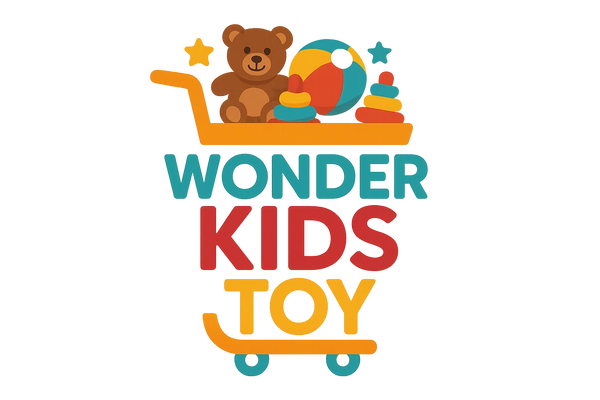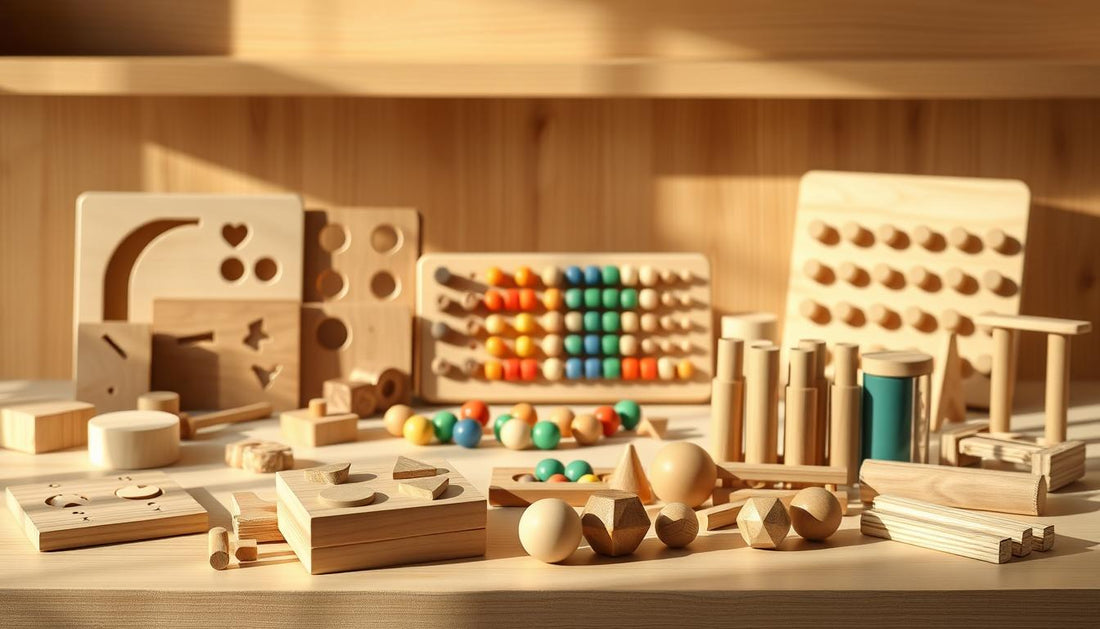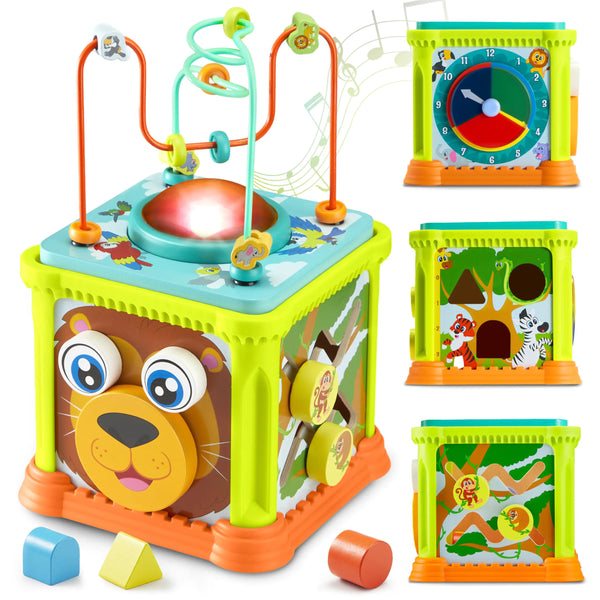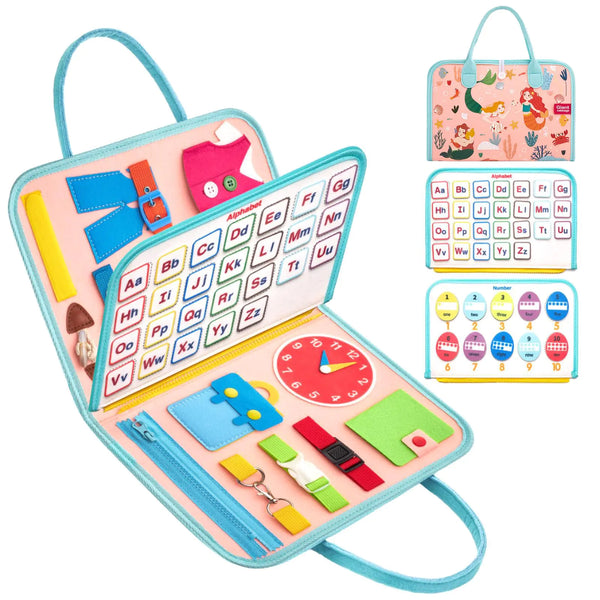As a Montessori-trained educator, I've learned the importance of educational toys. These toys help kids learn by doing and exploring.
My training shows me that Montessori focuses on kids learning on their own. It encourages hands-on activities and playing together. I choose toys that encourage kids to learn and grow.
I look for toys that match these ideas. This way, I help kids develop in all areas.
Key Takeaways
- Understanding the Montessori method's emphasis on self-directed learning.
- Selecting toys that promote hands-on activity and collaborative play.
- Recognizing the importance of educational toys in child development.
- Applying Montessori principles to toy selection.
- Fostering a child's natural desire to learn and grow through play.
Understanding Montessori Principles
It's key to know the Montessori principles to pick the right toys for a child's learning. The Montessori way focuses on child-led learning. This means kids get to explore and learn at their speed.
The Importance of Child-Led Learning
Child-led learning is at the heart of Montessori. It lets kids take charge of their learning. This builds their independence and self-motivation.
It also helps them develop problem-solving skills and critical thinking. These are important for their brain growth.
The Role of Hands-On Materials
Hands-on materials are key in Montessori education. They engage a child's senses and improve their fine motor skills. Montessori materials are made from natural materials and last a long time. They meet a child's developmental needs.
Fostering Independence through Play
Fostering independence through play is another Montessori principle. Giving kids the freedom to choose their play helps them take charge of their learning. This builds their self-confidence.
It lets them explore and learn without fear of failure.
Using these principles when picking developmental toys helps support a child's growth. Choosing toys that follow Montessori principles creates a learning-friendly environment.
The Benefits of Montessori Toys

Montessori toys offer many benefits, like boosting brain growth and helping kids get along better. They make playtime a chance for kids to grow in many ways.
Enhancing Cognitive Development
Montessori toys are key to kids' brain growth. They help kids think deeply and solve problems by engaging in hands-on activities. For example, open-ended toys spark creativity and let kids dream up new ideas.
- Promote critical thinking
- Encourage problem-solving skills
- Foster creativity and imagination
Encouraging Problem-Solving Skills
Montessori toys, like those that feel and look different, help kids solve problems. They make kids use their senses to learn about the world around them.
Some benefits of sensory toys include:
- Enhancing sensory awareness
- Developing fine motor skills
- Encouraging exploration and discovery
Supporting Social Interaction
Montessori toys also help kids get along better by making them play together. This teaches them essential social skills like talking, working together, and respecting each other.
By playing together with Montessori toys, children can:
- Develop communication skills
- Learn cooperation and teamwork
- Foster mutual respect and understanding
How I Choose Montessori Toys

I carefully pick Montessori toys to help my child grow. I look at many things to make sure they are fun, educational, and safe.
Evaluating Materials for Safety and Sustainability
I always check the toy's material first. I like toys made from wood because they are eco-friendly and last a long time. Wooden toys are strong and can be kept for years, which is good for the planet.
For safety, I check if the toy has a safety seal. I also make sure it has non-toxic paints and materials. This is important so children can play safely.
Focusing on Open-Ended Play
Toys need to encourage creative play. Montessori toys let kids use their imagination. For example, a wooden block can be anything a child wants it to be.
"The greatest sign of success for a teacher is to be able to say, 'The children are now working as if I did not exist.'"
This quote by Maria Montessori shows the value of letting kids lead in their play. By picking toys that support independent play, I help my child think creatively and solve problems.
Prioritizing Age Appropriateness
I make sure toys match my child's age and developmental level. Montessori toys are just right for kids, helping them feel confident and learn new things. For example, babies need toys that help them think and explore, while toddlers can handle more challenging toys.
| Age Group | Recommended Toys | Skills Developed |
|---|---|---|
| Infants (0-12 Months) | Sensory toys, wooden rattles | Sensory awareness, motor skills |
| Toddlers (1-3 Years) | Stacking toys, simple puzzles | Problem-solving, fine motor skills |
| Preschoolers (3-6 Years) | Complex puzzles, practical life toys | Independence, cognitive development |
By considering these principles and selecting toys that align with them, I help create a supportive environment for my child's growth.
Essential Montessori Toy Categories

The world of Montessori toys is full of variety. It includes practical life toys, sensory toys, and educational puzzles. These toys help with different skills, from everyday tasks to thinking abilities.
Practical Life Toys
Practical life toys help kids improve their hand skills and become more independent. They are like real-life tasks, like pouring or sorting. This lets kids practice and get good at these things.
Examples of practical life toys include:
- Pouring cups
- Sorting boards
- Mini brooms and dustpans
Sensory Toys
Sensory toys are designed to encourage kids to explore and learn. They have different textures, colors, and sounds. This helps kids understand their senses better.
Some examples of sensory toys are:
- Texture balls
- Sensory mats
- Sound boxes
Educational Puzzles
Educational puzzles challenge kids to solve problems and think. They come in many types, like jigsaw puzzles or shape sorters. Each puzzle is made for a certain age and skill level.
Benefits of educational puzzles include:
- Enhancing problem-solving skills
- Improving cognitive development
- Fostering patience and persistence
In conclusion, Montessori toys are divided into three main types: practical life toys, sensory toys, and educational puzzles. Each type has its role in a child's growth. Knowing this helps parents and teachers choose the right educational toys and Montessori materials.
My Favorite Montessori Toy Brands

In my search for the perfect Montessori toys, I found several brands that stand out. They create developmental toys that are both fun and educational. These brands have won my child's heart, making learning a joy.
Exploring Popular Options
Popular Montessori toy brands offer a variety of wooden toys and materials. Grimm's and Ostheimer are known for their high-quality, eco-friendly wooden toys. They are both beautiful and educational.
These brands focus on creating toys that are both fun and educational. Their toys have simple, elegant designs that spark imagination and creativity.
Nurturing Creativity and Imagination
Montessori toy brands that boost creativity and imagination are key. They give kids the tools to explore, create, and learn at their own pace. Melissa & Doug, for example, offers a wide range of toys that encourage artistic expression and imaginative play.
Choosing toys from these brands means my child is learning essential skills while having fun. The focus on creativity and imagination lays a strong foundation for future learning and growth.
Supporting Local Artisans
I also value Montessori toy brands that support local artisans. This ensures the toys are made with care and helps the local economy.
Brands that work with local artisans create unique, handmade toys. These toys have a personal touch and are sustainable. They are exceptional and can be treasured for years.
Building a Montessori Playroom

Designing a Montessori playroom is all about creating a space for exploration and learning. It's essential to make a playroom that encourages kids to learn on their own. This kind of space helps kids become independent and enjoy meaningful play.
Organizing Space for Learning
Setting up a learning space means choosing and arranging materials wisely. I make sure toys and materials are easy for kids to reach. This helps them play independently and learn by themselves.
To do this, I focus on a few key things:
- Open shelving allows for easy access to toys and materials for kids.
- Different areas are provided for activities such as reading, puzzles, and practical life exercises.
- Good lighting, with both natural and artificial light, to make the space bright and inviting.
Creating an Inviting Environment
An inviting space sparks curiosity and encourages kids to explore. I use different textures, colors, and materials to make the playroom engaging.
Here are some important considerations:
- Natural materials like wood and plants add warmth and life to the space.
- A calm color scheme helps kids relax and focus.
- Decor that shows the child's interests and personality makes the space feel personal.
Selecting Furniture that Supports Play
Furniture that supports play is key to a great Montessori playroom. I look for pieces that are the right size for kids, durable, and versatile. This lets kids move around and try different activities.
| Furniture | Purpose | Benefits |
|---|---|---|
| Child-sized tables and chairs | Supports practical life activities and group work | Promotes independence, social interaction, and fine motor skills |
| Low shelves and storage units | Provides accessible storage for toys and materials | Encourages self-directed play and organization |
| Comfortable reading nooks | Creates a cozy space for reading and relaxation | Fosters a love for reading and quiet contemplation |
By thinking about these elements, I can make a Montessori playroom that supports learning and inspires exploration.
Montessori Toy Recommendations by Age

Understanding the right toys for each age has been key to my child's growth. As kids get older, their needs change. The right toys can boost their learning, social skills, and physical abilities.
Infants (0-12 Months)
Sensory toys are vital for infants. They spark their senses and encourage them to explore. Examples include soft toys, sound toys, and visually appealing objects—these toys aid in developing their senses and motor skills.
Toddlers (1-3 Years)
Toddlers thrive with practical life toys that improve their fine motor skills and independence. Wooden blocks, stacking cups, and simple puzzles are great. These toys boost problem-solving and prepare them for more complex tasks.
Preschoolers (3-6 Years)
Preschoolers can tackle more challenging educational puzzles and open-ended toys. These toys, like complex puzzles, building sets, and art supplies, sharpen their problem-solving and creativity. They help grasp concepts like geometry and physics.
| Age Group | Recommended Toys | Benefits |
|---|---|---|
| Infants (0-12 Months) | Sensory toys, soft toys with different textures | Stimulates senses, encourages exploration |
| Toddlers (1-3 Years) | Practical life toys, wooden blocks, and stacking cups | Develops fine motor skills, independence |
| Preschoolers (3-6 Years) | Educational puzzles, building sets, art supplies | Enhances problem-solving skills, creativity |
Choosing eco-friendly toys is also wise. These toys support learning and teach about sustainability. They show kids the value of caring for the environment.
Integrating Montessori Toys into Daily Life

I've found that incorporating Montessori principles into daily life significantly enhances a child's learning experience. It makes learning fun and engaging.
Encouraging Collaborative Play
Collaborative play is key in Montessori education. It teaches kids to work together, respect each other, and solve problems. This helps them learn essential life skills.
- Providing a variety of Montessori materials that cater to different interests and age groups.
- Creating a play environment that fosters interaction and cooperation.
- Engaging in play with the child, demonstrating how to share and take turns.
Using Toys for Everyday Learning
Montessori toys are made to teach and help kids grow. They help with problem-solving and hand-eye coordination. This makes learning fun and interactive.
| Toy Type | Learning Outcome | Age Group |
|---|---|---|
| Practical Life Toys | Fine motor skills, hand-eye coordination | 1-3 years |
| Sensory Toys | Sensory awareness, exploration | 0-2 years |
| Educational Puzzles | Problem-solving skills, cognitive development | 2-5 years |
Balancing Structured and Unstructured Play
It's vital to mix structured and unstructured play. Structured play teaches specific skills. Unstructured play encourages creativity and independence.
"The goal is to create a balance that allows children to explore, learn, and grow at their own pace."
By mixing both, my child gets to play in a way that's both guided and free. This helps them grow and develop in all areas.
The Impact of Montessori Toys on My Child

I've seen how Montessori toys shape a child's learning journey. These educational tools have brought significant benefits to my child's thinking and social skills.
Observing Progress and Development
Watching my child grow with Montessori toys is incredibly rewarding. They start with simple tasks and move on to harder ones. This shows how well these toys work.
Montessori materials let my child learn at their own speed. This builds their independence and confidence.
Incorporating Feedback into Selection
I choose new toys based on what my child likes and learns. This keeps the toys fun and just right for them.
By understanding my child's learning style, I pick toys that fit their needs. This makes learning more fun for them.
Appreciating the Journey of Learning
The Montessori method sparks a love for learning that lasts. It makes my child curious and excited to discover new things.
Looking back, Montessori toys are more than just tools. They inspire my child to explore, ask questions, and keep learning.
Addressing Common Misconceptions

Many think Montessori is only for schools. But Montessori ideas work in homes too. They help kids grow in many ways.
Montessori is Not Just for School
At home, Montessori methods work. Using wooden toys and hands-on learning materials can be particularly helpful. This creates a caring space for kids to grow.
Toys Aren't About Labels but Learning
Some think you need labeled Montessori toys. But it's about the learning, not the label. Sensory toys are great, whether they're called Montessori or not.
| Misconception | Reality |
|---|---|
| Montessori is only for schools | Montessori principles can be applied at home |
| Toys need to be labeled Montessori | The focus is on the learning experience, not the label |
| Montessori toys are expensive | Quality Montessori toys can be affordable, such as wooden toys |
Affordability of Quality Montessori Toys
Some Montessori items can be pretty expensive. But there are cheaper options. Wooden toys are durable and good for the planet. They're a wise choice for quality play.
Reflecting on My Montessori Journey

My journey with Montessori has changed me and my child. It has profoundly impacted our lives.
The use of open-ended toys in Montessori has stood out to me. These toys, often from natural materials, are fun and educational. They help my child learn and grow.
Growing Together
Montessori has taught me about personal growth through child development. Watching my child learn has shown me their strengths and needs. It's rewarding to see the world through their eyes.
The Joy of Sharing Knowledge
Teaching my child is a joy every day. Montessori promotes a learning environment where kids can explore at their own pace. Using eco-friendly toys makes learning more real and good for the planet.
Lifelong Learning through Play
Montessori believes in learning through play. This has made our home a place of curiosity and creativity. Open-ended toys are key, as they keep challenging my child to learn more.
In summary, Montessori has brought growth, learning, and joy to our lives. It has changed how I parent and choose toys, focusing on sustainability and creativity. I'm excited to see the future benefits for my child.
Resources for Further Learning

As I explore Montessori, I'm eager to share resources that have helped me grow. There are many resources for those keen to learn more. They offer valuable insights and guidance.
Recommended Books on Montessori Education
Books on Montessori have been key to my learning. "The Montessori Method" by Maria Montessori is foundational. It explains the Montessori philosophy.
"Montessori from the Start" by Paula Polk Lillard and Lynn Lillard Jessen is also essential. It gives practical tips for starting Montessori early. Other books, like "The Absorbent Mind" by Maria Montessori, have also been very helpful. They mix theory with practical advice, enriching my understanding.
Online Courses and Webinars
Online courses and webinars have also been great for my education. Sites like Coursera, edX, and the Montessori Institute offer a variety of courses. They let me dive deep into topics at my speed.
Webinars have given me the latest on Montessori research and practices. They feature experienced educators and connect me with others who care about Montessori.
Community Support and Networking
Connecting with others has been a highlight of my Montessori journey. Joining local groups and attending conferences has been rewarding. These communities offer support, share resources, and create a sense of belonging.
Through these connections, I've seen new perspectives and learned about innovative Montessori practices. The community's support has been a big motivator for me.
Conclusion: The Power of Montessori Toys
My journey with Montessori toys has changed us all. It's not just about my child; it's about our whole family. We've found a new way to enjoy play and learn together.
Selecting Toys that Matter
Choosing the right Montessori toys is key. I seek out toys that help with thinking, solving problems, and getting along with others. Seeing my child grow and learn in new ways is genuinely amazing.
Fostering a Love of Learning
The joy of learning is central to Montessori. It's helped us all love learning more than ever. Montessori toys have made learning a natural part of our day.
Exploring Montessori
Check out Montessori toys for your child. They can help create a space where your child can grow, be creative, and love learning forever.
FAQ
What are the key principles of the Montessori method that I should consider when selecting toys?
The Montessori method focuses on self-directed learning and hands-on activities. It also values collaborative play. When picking toys, I look for these qualities to help my child learn and grow.
What types of materials are used in Montessori toys, and why are they important?
Montessori toys often use natural materials like wood. These materials are eco-friendly and help create a caring environment. They encourage exploration and creativity.
How do Montessori toys support cognitive development in children?
Montessori toys boost cognitive skills by promoting critical thinking and problem-solving. Open-ended toys, in particular, spark creativity and imagination.
What are some essential categories of Montessori toys that I should consider?
Key Montessori toy categories include practical life, sensory, and educational puzzles. These toys support various skills, from fine motor to problem-solving.
How do I choose Montessori toys that are suitable for my child's age and developmental stage?
I choose toys based on my child's age and stage. This ensures they are both challenging and accessible. It fosters a lifelong love of learning.
Are Montessori toys only for children in Montessori schools, or can they be used in other educational settings?
Montessori toys are for all educational settings, not just Montessori schools. They support a child-led approach to learning.
How can I integrate Montessori toys into my daily routine to support my child's learning?
I incorporate Montessori toys into daily life to encourage collaborative play. This helps in using toys for everyday learning and balances structured and unstructured play.
What are some common misconceptions about Montessori toys, and how can I address them?
Some think Montessori toys are only for school or too expensive. Exploring affordable options and understanding their benefits helps address these misconceptions. It creates a nurturing environment for my child.
How can I find Montessori toy brands that align with my values and support my child's development?
I look for brands that offer high-quality, developmental toys from natural materials like wood. They should also support local artisans and sustainable practices.
What resources are available to help me learn more about Montessori and how to implement it in my home?
There are books, online courses, and webinars on Montessori education. Community support and networking opportunities also help me learn and implement Montessori at home.















